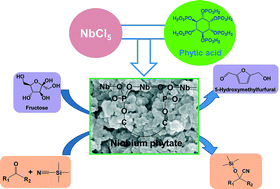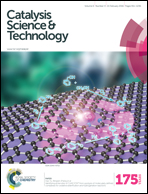Niobium phytate prepared from phytic acid and NbCl5: a highly efficient and heterogeneous acid catalyst†
Abstract
The preparation of functional catalysts using naturally-occurring building blocks is of great importance. In this work, we designed a functional heterogeneous acid catalyst, niobium phytate, using phytic acid, which could be obtained from the seeds and grains of plants, as the building block to react with NbCl5. The prepared niobium phytate was characterized by XRD, FT-IR, XPS, SEM, TEM, NH3-TPD and N2 adsorption–desorption examinations. Niobium phytate showed very high activity for both cyanosilylation of carbonyl compounds and dehydration of carbohydrates. It was also found that niobium phytate had higher activity than commercial Nb2O5. In addition, niobium phytate could be easily recovered and reused without reducing the reaction activity considerably. Further study indicated that both higher acidity and lower crystallinity contributed significantly to the excellent catalytic performance of niobium phytate. The findings in this work provide insights into the design of new functional catalysts using naturally-occurring building blocks for various organic reactions.


 Please wait while we load your content...
Please wait while we load your content...